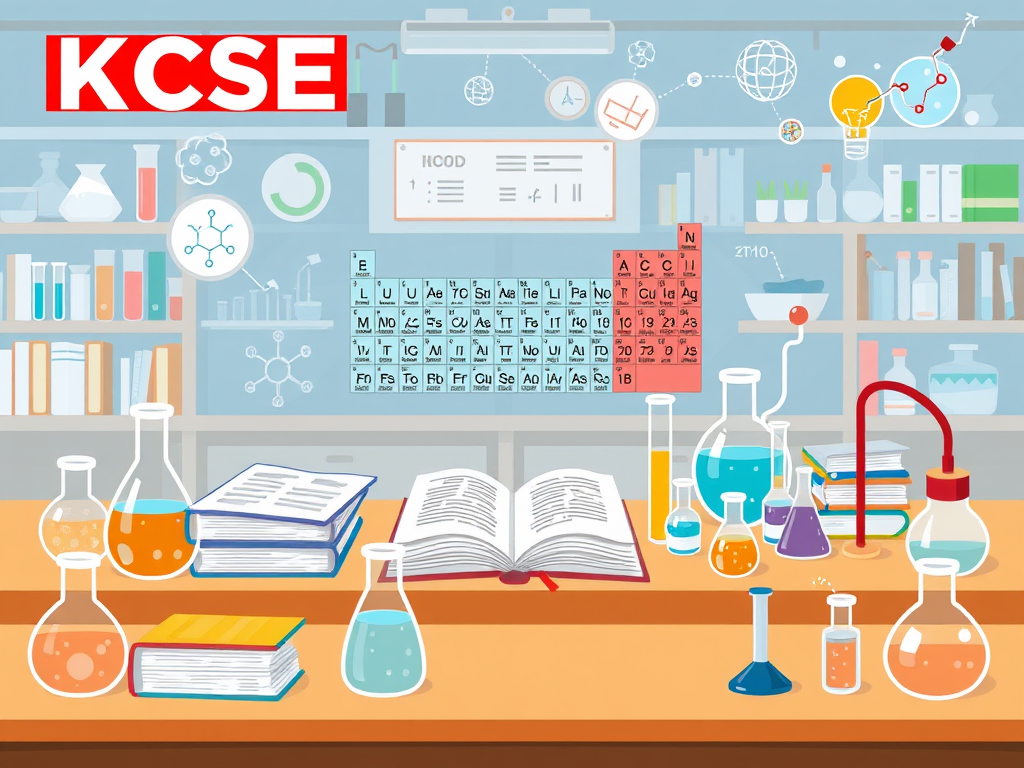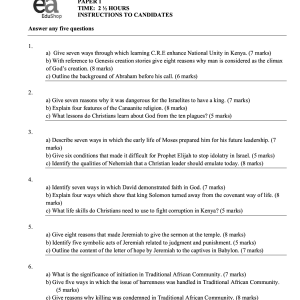Description
The document is a chemistry examination paper for the Kenya Certificate of Secondary Education (KCSE), specifically Paper 2, which focuses on theoretical concepts in chemistry. It consists of various sections, including instructions for candidates, several questions, and a marking scheme. Below is a comprehensive overview of the key sections and topics covered:
General Structure
- Title and Instructions: The paper is titled “CHEMISTRY PAPER 2 (THEORY)” and instructs candidates on how to fill in their details (name, index number, etc.) and answer the questions.
- Scoring: The paper includes a section for expected scores and candidate scores for each question, totaling a maximum of 80 marks.
Question Breakdown
- Electron Arrangement and Element Properties:
- Candidates are asked to deduce electron arrangements for elements based on given ion configurations.
- Questions explore properties of elements, such as states at room temperature, oxide formation, and types of chemical bonds.
- Chemical Reactions:
- A section asks candidates to write chemical equations for reactions, analyze mass changes during reactions, and identify catalysts.
- Questions about equilibrium in reactions and how changes in temperature and pressure affect equilibrium positions are included.
- Electrochemistry:
- Candidates must interpret standard reduction potentials, identify reducing agents, and write ionic equations for reactions involving electrolysis.
- Questions on the electrolysis of water and copper(II) sulfate are included, along with calculations related to electricity and mass of metals obtained.
- Solubility and Temperature:
- A section involves experiments to determine the solubility of potassium chloride (KCl) at different temperatures, requiring candidates to analyze data, draw graphs, and deduce solubility trends.
- Electrolytic Processes:
- Candidates answer questions related to the Downs cell and the production of sodium, including the materials used for electrodes, precautions to prevent recombination of products, and the role of added salts to lower melting points.
- Organic Chemistry:
- Questions involve identifying compounds based on structural formulas, naming them systematically, and discussing their boiling points and reactions.
- The document covers polymerization and the properties of different types of detergents.
- Heat of Reaction:
- Candidates are asked to define molar heat of neutralization, write thermochemical equations, and draw energy level diagrams.
- Calculations:
- Many questions require calculations involving chemical quantities, such as determining the mass of products formed from given reactants and analyzing thermodynamic properties.
Marking Scheme
- The document includes a marking scheme that provides answers and grading criteria for each question, detailing what constitutes correct and complete responses.
Conclusion
Overall, the document is a comprehensive assessment tool for chemistry students, designed to evaluate their understanding of theoretical concepts, practical applications, and problem-solving abilities in chemistry. It covers a wide range of topics, including inorganic chemistry, electrochemistry, organic chemistry, and thermodynamics, ensuring a thorough examination of the candidates’ knowledge and skills.




Reviews
There are no reviews yet.